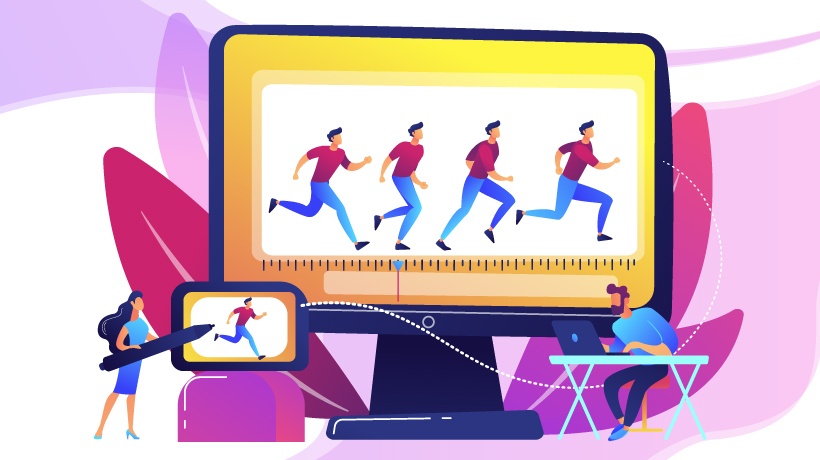Using Animation To Boost Students' Motivation
There is one tool that has proven to be effective in strengthening students’ motivation that you might want to take a look at—animation. But be careful, as easy as it is to use, animation can also be misused and abused. So stay with me until the end of the article and you will find out how to properly deploy animation in your teaching.
How Important Is Students’ Motivation In eLearning, Really?
Students’ motivation plays a vital role in an online learning environment. It directly affects their engagement, learning outcomes, as well as how they feel about the course. Motivating students is undoubtedly a challenge that teachers have to face every day. The problem becomes 10 times more challenging for educators and Instructional Designers who are launching self-paced online courses where there’s hardly any interaction between students and their peers and teachers. Without a good strategy to raise morale, online learners can easily lose motivation and drop out halfway.
How Can Educational Animations Motivate Students In Online Courses?
According to educational psychology theories, there are two kinds of motivation: intrinsic motivation and extrinsic motivation. Extrinsic motivation entails things that reward behavior, “If you do this, you get this,” while intrinsic motivation comes from within the student, namely their interest or desire to learn.
Educational animation can provide students with both kinds of motivation. Animations have an amazing ability in explaining complicated ideas. This enhances students’ understanding, giving them a sense of accomplishment and triumph.
Concentration Booster
The average attention span has shortened considerably over the past few years with the advent of the internet and the smartphone. Research by Microsoft shows a shocking fact that people nowadays generally lose focus after only 8 seconds, 1 second shorter than a goldfish’s memory span. A well-designed online course should be able to keep students focused throughout the whole learning process.
An additional benefit of animation is that it gives learners a break by keeping them entertained. A series of short animated videos is much more appealing than 100 PowerPoint slides and can help students digest information more easily.
Amazing Explainer
“Show, don’t tell.”
Every writer should have heard this quote and internalized it. It’s much better to show people how things work than waste a lot of time trying to explain something. According to Forrester Research, one minute of video equates to 1.8 million words. While texts force the brain to imagine images, videos show them right away. If you want your students to understand as quickly as possible, especially complicated matters, try to simplify the content and convert it into highly visual and engaging animated videos.
Take a look at how books are converted into animations in the showreel of the Permaculture Design online course.
Fresh And Exciting Experience
Animations are an incredible storytelling device that totally does away with the notion that studying is tedious and boring. Whether it’s the character or the lesson content itself, animation can breathe new life into the lesson, making it funny and emotional, however the educator prefers. Humor is a very effective ingredient that can make a class interesting, keep that in mind.

If learning is fun, the learners have an easier time concentrating because they’re excused from the long, tedious hours of reading black and white documents. If this doesn’t reignite their enthusiasm, I don’t know what can. Nothing beats being genuinely interested in what one is learning.
How Can You Use Animation To Boost Students' Motivation?
Animation can greatly increase enthusiasm in learning, but only with proper usage. Too much can be a distraction, which misses the whole point. So here are 5 tips on how to properly deploy animation in teaching.
1. Keep It Shorter Than 5 Minutes
Unless your audience consists of doctors or businessmen intensely focused on learning the topic, your best bet is that their attention rate will decrease slowly and slowly until you surpass that 10-minute mark.
And let’s not ignore the obvious fact that you’ll be wasting a lot of time making a long animation. So do yourself and the organization a favor, keep it short, preferably 3-5 minutes.
2. Create Mesmerizing Designs
Be as creative as possible with your character designs. Avoid simple, thin lines and neutral colors if you can. The animation has to be captivating or else learners are not going to enjoy it and lose interest.
However, there will be cases where you should keep things plain and simple. For example, when you’re dealing with scientific matters, like describing a natural event, you should keep the colors and images accurate rather than go all out with your coloring. Stick to the minimal design style, only include what’s necessary.
3. Don’t Use Too Much Text
Your audience can read faster than what can be talked in the animation. Opt for a narrator instead. A wordy frame isn’t captivating at all. Unfortunately, our attention span has shortened considerably and we just don’t enjoy reading like before, so there’s really no point in trying to make students read a bunch of texts in a 5-minute animation.
Instead, keep information in the form of one-liners, keywords, or pictures. Don’t waste your and everyone else’s time typing 1000-word prose into the video.
4. Create Interesting Characters
Your animated characters are not subject to the laws of physics like us. They can do anything you want them to do, including what you only wish you could do in real life. For example, with topics like medicine and construction when you need to explain what happens inside your body on a microscopic level or building sewers, you can introduce animated humans into such settings. They won’t complain, trust me.
But the most important point is animated characters can express feelings better than real people. They can turn their faces red when angry, or literally give that "puppy look" and a disgusted glance just seconds later. And because of this, animated characters can convey feelings to the most extreme level, consequently capturing the learners’ attention as if they were watching a Hollywood movie, reeling them in without them noticing.
5. Don’t Forget To Make It Fun
When you incorporate humor into your content, it becomes much more relatable and appealing, especially if your students are young. But if the topic is something serious like bullying or mental illness, try not to make it funny, some might interpret it as offensive.
Conclusion
Motivation is crucial in contributing to the success of an online course. Thanks to the development of technology, we have animation—an incredible tool—by our side. With animation, you can vastly increase students’ motivation and engagement. But beware, you might turn it into a double-edged sword. Feel free to experiment and find out what works for you, and your online course will have no problem succeeding.
Read more on animation in eLearning:
- 3 Vital Points To Keep In Mind When Using Animation In Education
- Everything You Need To Know About Animation-Based Learning
- How To Create A Positive eLearning Environment With Animation
- 3 Crucial Elements Needed To Create A Good Animated Video In eLearning








